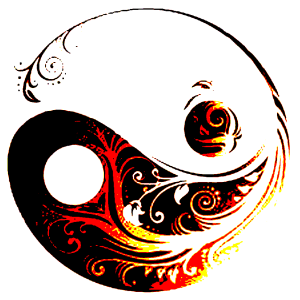Yin and Yang in Food...
Balance Yin and Yang in Food... and... find Balance in Life...
Yin and Yang in Food
'Yang cannot exist by itself; it can exist only when it is supported by yin.
Hence yin is the foundation of yang.
Similarly, yin cannot alone manifest itself; it can manifest itself only when accompanied by yang.
Hence yang is the expression of yin.
Yang controls the origination and enjoys the completion [of things] while yin follows the way [yang produces] and completes the work of yang.
~ Shao Yong, (1012-1077), Philosopher
Yin and Yang in Food - the Base of Balance
The Yin and Yang opposite principle can be applied throughout our daily life, on every level.
In the natural world everything contains these two opposite components. They not only oppose each other, but also contain each other – one cannot exist without the other – coexisting and interdependent – complementing each other.
Every tissue and organ can be assigned to either Yin or Yang, and at the same they are inter-connected and function intimately together.
The assignment to Yin and Yang greatly facilitates the understanding of the highly complex physiology and pathology of the body.
Yin Foods, Yang Foods
"There are four factors that determine whether a food is yin or yang:
• How the food grows (including speed and direction).
• Where the food was grown (in northern or southern climates).
• The sodium-potassium content.
• And the effect the food has on the body (hot or cold effects).
In terms of mineral elements, Yin represents foods rich in potassium,
while Yang foods are high in sodium.
In general, yin foods are considered "cool," larger, have less salt, have potassium, and/or grow above soil. Yang foods are "warm" or "hot," smaller, have more sodium, and/or grow below the soil. In addition to eating yin or yang foods, to maintain balance followers of the philosophy believe you should increase thee intake of "cool" foods (yin) when it is hot, and "hot" foods (yang) when it is cold. In addition to yin and yang, there are five elements, which must also be balanced. Each element is associated with a particular food quality and the ideal meal includes all five."
from Macrobiotic Guide
Yin Foods
Yin foods, such as fruit, juice, sugar, alcohol and certain drugs (marijuana, for example, and many pharmaceuticals) have a yin or expansive effect.
They cause relaxation, dispersion of energy, and eventually lethargy and reduced movement.
In the body, yin foods cause organs to expand and relax. With excess consumption of Yin foods, organs become expanded, worn-out and weak. They accumulate waste products, become deformed, and eventually become ill.
Yin foods typically affect the upper part of the body, at the diaphragm and above, including the heart, pancreas, spleen, liver, upper part of the lungs, neck, head and brain.
Yin Classification
Interior, tendons, bones, Yin meridians, essence, blood, body fluids.
Yang Foods
Yang foods tend to affect the heart and the organs below the heart, such as the lower part of the lungs, digestive track, large intestines and reproductive organs.
Excess consumption of animal foods is associated with high rates of heart disease and many forms of cancers. Animal derived foods are especially Yang.
Yang Classification:
Yang – Exterior, back, lateral side of limbs, skin, muscle, Yang meridians.
Yin-Yang Attraction in Foods
Yin and Yang are continuously attracting each other to create balance. This is why people who eat a lot of Yang foods, such as beef and eggs, suffer from their contracting effects on the body and therefore are attracted to Yin foods, such as sugar or alcohol, to create a more balanced condition.
For example, bartenders put salty peanuts (Yang) on the bar in order to encourage drinking (Yin). After a day of demanding work (Yang) people want sugar or alcohol (Yin) to help them relax. Smokers will enjoy their cigarette (Yang) with a good cup of coffee (Yin).
All foods are either Yin or Yang - at different levels – Sugar and apple juice for example are both Yin, but sugar is far more expansive and weakening than apple juice.
Whole grains are considered slightly yang, but not nearly as Yang as fish or foods that are even more contracting such as beef, chicken and eggs.
Beans are considered less Yang than grains.
Vegetable, in general, are considered Yin. Root vegetables are the most Yang of the vegetables.
Fruit is more Yin than vegetables and fruit juice more Yin than fruit.
It's easy; once you get the feel for it...
In general, the more processed a food is, the more Yin it is.
The foods and drinks most of our children are eating – soda, sugar, snacks, cookies – are extremely yin, causing the body to expand... resulting in overweight, obesity or hyperactivity (followed by sluggishness).
Health is the result of balance within the body – less extreme contraction and less extreme expansion.
The center of the Yin-Yang spectrum is where balance and health can be found.
Related Pages:
From 'Yin and Yang in Food' back to 'Home Page'




